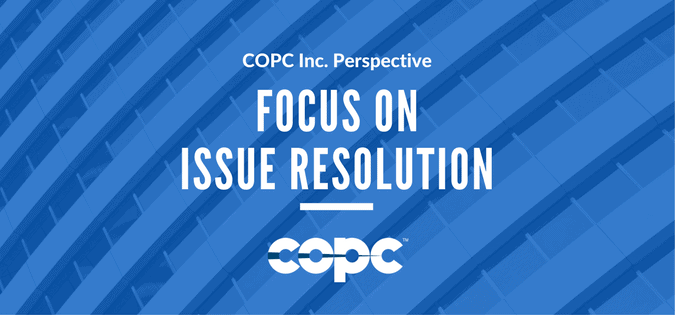
January 19, 2017
Is an Omnichannel Environment Truly Attainable?
COPC Inc. Recommends that Issue Resolution Should Instead be a Company’s Primary Focus
“Customers expect to receive service on the channel of their choice, whether it’s phone, email, text, chat, web, mobile, or social media, and want to be able to start an interaction in one channel and then seamlessly transition to another,” according to a recent article in CRM magazine by Senior Editor Leonard Klie.
Consumer research conducted by COPC Inc. confirms that customers expect to receive service in their channel of choice. Mr. Klie’s article does a good job in covering all the areas that are required for omnichannel integration. However, we believe that issue resolution should be the top priority rather than integration.
Providing a successful interaction within a customer’s first-chosen channel is more important than the ability to “seamlessly transition to another” channel. The need to transition from one channel to another implies an assumption of failure, where the customer was unable to achieve their desired outcome in their first channel of service. A successful resolution within that first channel should be a company’s primary focus.
Our experience at COPC Inc. has found that it is dangerous to focus on omnichannel capability before addressing the effectiveness of issue resolution within individual channels. This is not to suggest that a company should continue operating in self-contained channels or not aspire to a omnichannel experience. Instead, we recommend more collaboration between departments to ensure each channel offers an experience that is satisfactory to the customer.
A simple example of successfully prioritizing issue resolution and collaboration over omnichannel integration can be seen in the cable industry. One of the most aggravating experiences for a cable customer is the need for a service call, but we all know it happens. Although the issue could not be resolved without the service call, a positive customer experience can be delivered when a cable provider focuses on providing a positive customer experience through resolution during the service call.
For example, on the day of the service call, they proactively remind customers of the estimated arrival time; they provide an online and/or mobile ability to track their assigned technician; they allow customers and agents to modify appointments in real time as needed; and, most importantly, they ensure technicians have the technology, processes and training that allow them to resolve customer issues without repeat visits.
All of these activities require increased cooperation between the customer service department and the groups that manage and dispatch service technicians, as well as a concerted effort to focus on issue resolution during the service call. In this example, although the customer experience involves different communication channels, they are not necessarily all integrated. However, to the customer that does not matter because their underlying needs are being met—knowing estimated arrival, tracking their service, having the ability to change appointments when needed, and ultimately getting their issue resolved.
While it would be nice for customers to be able to seamlessly transition from one channel to another, if the customer’s needs are met in their channel of choice–phone, social media, chat, online, mobile– there is no need for a transition. For most customers, avoiding the need to contact a company in the first place and having the ability to resolve an issue on first contact will be much more impactful to both their level of satisfaction and the company’s profitability.
You can read Mr. Klie’s full article in the December issue of CRM magazine.